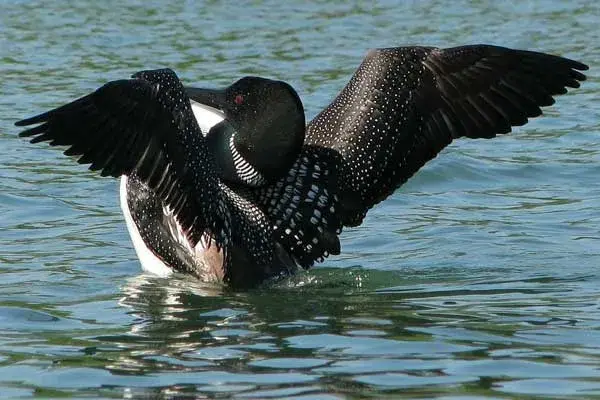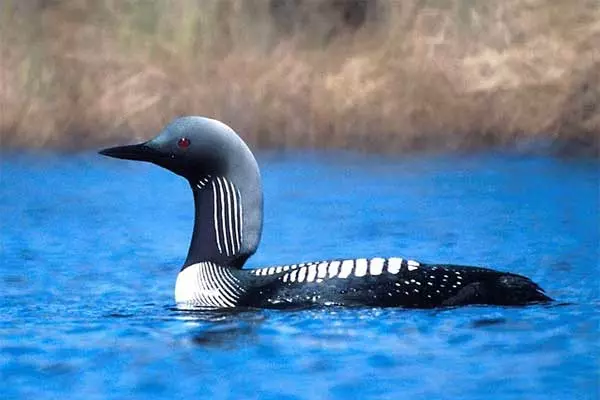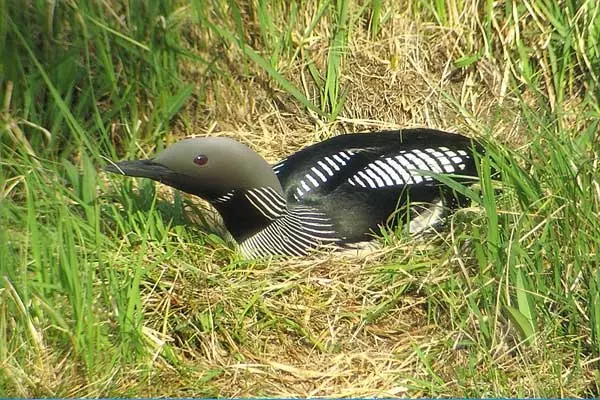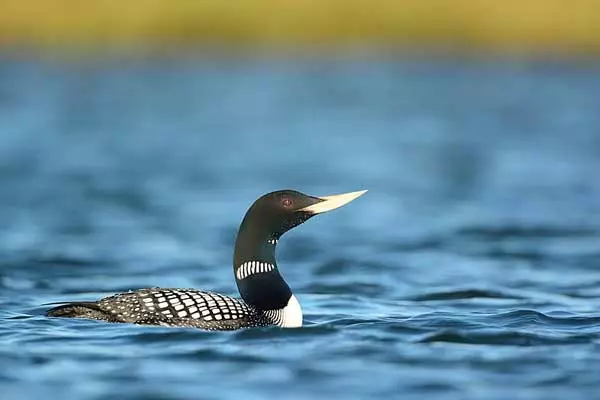Loons are water birds that only go ashore to mate and incubate eggs. They are the size of a big duck or a small goose, but their feet are farther back on the body, they have longer beaks, and sit lower in the water than ducks do.
There are five species or types of loons that can be spotted in Canada: the Red-throated Loon, Pacific Loon, Common Loon, Yellow-billed Loon, and Arctic Loon.
Loons live in Canada mostly in the northern parts of the country, although some species like the Common loon are more widespread.
Table of Contents
Loons In Canada
1. Red-throated Loon

- Scientific name: Gavia stellata
- Lifespan: up to 23 years
- Wingspan: 36-47 in (92-120 cm)
- Length: 22-26 in (55 to 67 cm)
- Weight: 2.2–6.0 lb (1–2.7 kg)
- Range In Canada: Summer resident in Northern Canada
The most widely distributed species of the loon family, the red-throated loon is a migratory aquatic bird found in the northern hemisphere. Weighing 4 lbs on average, it is the smallest and lightest of Canada’s loons.
Also considered one of the most graceful of all loons, the red-throated loon is easy to identify by the long gray and red neck, a thin daggerlike beak, and long, pointed wings.
Red-throated loon will often hold its dark beak upward while swimming and got its name from the distinctive reddish throat patch it develops during the breeding season.
It is among the finest fish hunters in North America, but will also eat some amphibians, invertebrates, and plants.
Red-throated loons are monogamous birds that form long-term bonds, and both partners will help build the nest, incubate the eggs, and take care of the young. Unlike other loons, red-throated ones do not carry their young on their backs.
Red-throated loons breed at high latitudes, nest in low densities on small ponds in coastal tundra ecosystems, and spend the majority of the remaining year (around 8 months) on coastal marine waters.
During summer, red-throated loons can be found in northern Canada where they breed.
When the colder weather comes, this loon will winter along North American coastlines. If you live in the eastern and western parts of Canada, you will have a good chance of spotting these birds during migration.
A 2018 study on migration patterns of Red-throated Loons discovered that on average, these birds will undergo long almost 4,000-mile-long fall and spring migrations predominantly along coastlines.
2. Common Loon

- Scientific name: Gavia immer
- Lifespan: 20-30 years
- Wingspan: 40-50 in
- Length: 26-35.8 in (66-91 cm)
- Weight: 88.2-215.2 oz (2.5-6.1 kg)
- Range In Canada: Summer resident throughout Canada
The common loon or the great northern diver is a species of loon found in Canada known for its striking appearance and haunting calls (the wail, tremolo, yodel, and hoot). This large, diving waterbird has a rounded head and dagger-like beak.
Loon Call
During summer, adults have black heads and bills, white breast color, and black-and-white spots on their backs. Common loons’ winter plumage is dark gray above and white on the necks and bellies. They acquire almost full winter plumage by mid-October and November.
Common loons are excellent divers that can stealthily submerge without a splash to catch fish.
They can go over 200 feet below the water’s surface, stay there for up to 5 minutes, and swallow their prey underwater. Common loons mostly feed on fish, crustaceans, insect larvae, mollusks, and occasionally aquatic plants.
In Canada, you can see these birds in most parts of the country during summer; except in the extreme north and the southern portions of the Canadian Prairies.
Their breeding season lasts from April to October, and common loons can be found in freshwater ecosystems ranging from Boreal lakes to open wetlands in Canada.
From October to November, common loons can be seen migrating to salt waters of the Pacific and Atlantic coastlines of North America. They will remain in bays and coves there until March when their spring migrations start.
Common loons will often migrate in stages, making stops at larger lakes like the Great Lakes to see if their lake has become free of ice. In general, you will be able to spot them returning to Canada around April and May.
Common loons are monogamous and the pair may breed together for a decade or more. Both the male and the female will often together defend a territory.
Although it isn’t Canada’s national bird, the common loon still appears on the Canadian currency and is the provincial bird of Ontario.
Ontario is currently home to more than one-third of the global population breeding common loons. However, the reproductive success of loons has been on a consistent decline there, dropping by 0.10 six-week-old young per pair per year.
Loons migrate from Ontario around October, generally moving further south to the Chesapeake and the Carolinas.
The common loon is one of the two types of loons found in Michigan.
3. Pacific Loon

- Scientific name: Gavia pacifica
- Lifespan: around 30 years
- Wingspan: 43-50 in
- Length: 23–29 in (58–74 cm)
- Weight: 2.2–5.5 lb (1–2.5 kg)
- Range In Canada: Summer resident in Northern Canada
This medium-sized diving bird can be seen in Northern Canada during summer when it breeds on tundra lakes. Pacific loons will winter in the open ocean or other large bodies of water along the Pacific coast of North America.
They are easy to recognize by their soft gray heads, intricate black-and-white patterning on the back and neck, long thick neck, and strong, pointed bill. Pacific loons look like smaller and sleeker versions of common loons.
When not in the breeding season, adults have dark gray-brown plumage above with very little white feather edging and whitish plumage below.
Pacific loons were long considered to be the same species as black-throated loons up until 1985 when they got classified as separate ones.
They are most vocal in the spring and summer and have a wide range of calls. Similar to the common loon, they might yodel or wail, along with a range of other smaller cackles, growls, barks, and clucking noises.
Pacific loons will build their nest on the ground near deep lakes, usually out of piled-up vegetation. Females will there lay a clutch of one to two light buff or green eggs with brown spots of various sizes.
Pacific loons are specialist fish-catchers that might also feed on some insects and crustaceans.
These beautiful loons of Canada are monogamous, form long-term bonds, and return to the same breeding grounds and nest sites year after year.
When breeding, Pacific loons become very territorial and can be even seen performing threat displays at passing airplanes.
4. Black-throated Loon

- Scientific name: Gavia arctica
- Lifespan: Around 12 years
- Wingspan: 39-51 in
- Length: 28 in (70 cm)
- Weight: 2.9 – 7.5 lb (1.3-3.4 kg)
- Range In Canada: Occasional winter resident in Western Canada
Also known as the Arctic loon and the black-throated diver, the black-throated loon is a medium-sized migratory bird that is an occasional non-breeding visitor to British Columbia.
You will recognize them by the gray heads and hindnecks, and black and white striped sides. Black-throated loons have most of their throats black, which is how they got their name.
They are often confused for Pacific loons with the main difference being the white color of the flanks on black-throated loons.
Although excellent fliers and swimmers, black-throated loons are clumsy on land, as their legs are positioned far to the posterior end of their bodies. They can’t take off from land and need a lot of open water to get in the air.
These migratory birds are carnivores and feed on fish, mollusks, and crustaceans. They usually forage alone or in pairs, rarely in groups, and will dive up to 16 ft to catch fish.
Black-throated loons can be found in different natural habitats, including the ocean, open water, and tundra lakes in the summer.
Similar to other loons, black-throated ones are monogamous and stay with their partners for many years.
The population of these loons is in decline and is protected under several laws.
5. Yellow-Billed Loon

- Scientific name: Gavia adamsii
- Lifespan: 20-30 years
- Wingspan: 53-63 in
- Length: 30-38 in (76-97 cm)
- Weight: 8.8-14.1 lb (4-6.4 kg)
- Range In Canada: Summer resident in Northern Canada
The yellow-billed loons are the biggest species of loons in Canada, found on large lakes in the high arctic tundra. They resemble common loons but have thicker necks and blockier heads.
If you encounter this loon in the wild, pay close attention to the straight upper edge and angled lower edge of its pale yellowish beak.
Breeding adults have gorgeous black upperparts, white underparts, gray sides with fine white spots, and glossy green-black heads.
Yellow-billed loons breed in the central Canadian Arctic and northern Alaska during summer.
From late August to mid-September, they will start their migrations to winter on the coasts of southern Alaska and northern British Columbia. They return to Canada around May, usually migrating alone or in pairs.
They have been recorded as vagrants in more than 20 countries, often reaching south as far as Mexico and Spain.
Like all divers, yellow-billed loons are specialists in catching fish underwater. They might also eat some crustaceans, mollusks, and some insects in summer.
Yellow-billed loons can be also identified by an eerie wailing with a lower pitch than the common loon’s call.
One of the rarest of all North American birds, yellow-billed loons are threatened by oil development in Alaska and Russia, drowning in fishing nets, overharvest, and the loss of their tundra habitat due to global warming. That’s why the International Union for Conservation of Nature (IUCN) lists the species as “Near Threatened”.
Summary
This concludes our list of loons in Canada.
Canada is home to several species of loons that look pretty similar. Loon species in Canada include the recognizable black-and-white Common Loon, the Red-throated Loon, the Pacific Loon, the Black-throated Loon, and the Yellow-billed Loon.
One of the longest-running and most popular monitoring programs of loons is the Canadian Lakes Loon Survey (CLLS). This initiative is aimed at monitoring, protecting, and preserving loon populations and their habitats in Canada. You can read about their research conducted to better understand loon behavior, biology, and population dynamics in Canada on this link.
People often mistake them for ducks – the main differences are that loons have feet that are farther back on their bodies, have longer bills, and sit lower in the water than ducks.
These birds can be good indicators of how healthy the environment is. If loons have a healthy population and successfully produce young, this usually means that the environment is healthy.
Next time, should you see these birds in wildlife, you should be able to recognize any of them with ease!
And if you enjoyed our article, here’s another popular read on birds: 15 beautiful blue birds found in Maryland